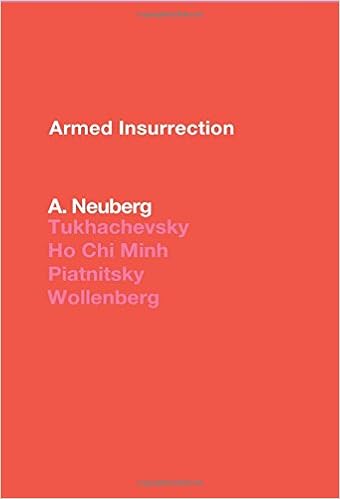 |
| Amazon link ... and PDF |
From Wikipedia (Third Period):
"The Third Period is an ideological concept adopted by the Communist International (Comintern) at its Sixth World Congress, held in Moscow in the summer of 1928."Armed Insurrection" was published illegally (in German) by the Comintern in 1928, following the Sixth World Congress. This was a book which could get you arrested or worse. Surely something to keep the bourgeoisie awake at nights, shuddering in their beds? The contemporary reader's reaction is likely to be that the manual is surprisingly boring.
The Comintern's theory was based on its economic and political analysis of world capitalism, which posited the division of recent history into three periods. These included a "First Period" that followed World War I and saw the revolutionary upsurge and defeat of the working class, as well as a "Second Period" of capitalist consolidation for most of the decade of the 1920s. According to the Comintern's analysis, the current phase of world economy from 1928 onward, the so-called "Third Period," was to be a time of widespread economic collapse and mass working class radicalization. This economic and political discord would again make the time ripe for proletarian revolution if militant policies were rigidly maintained by communist vanguard parties, the Comintern believed.
Communist policies during the Third Period were marked by extreme hostility to political reformism and political organizations espousing it as an impediment to the movement's revolutionary objectives. In the field of trade unions, a move was made during the Third Period towards the establishment of radical dual unions under communist party control rather than continuation of the previous policy of attempting to radicalize existing unions by "boring from within."
The rise of the Nazi Party to power in Germany in 1933 and the annihilation of the organized communist movement there shocked the Comintern into reassessing the tactics of the Third Period. From 1934, new alliances began to be formed under the aegis of the so-called "Popular Front." The Popular Front policy was formalized as the official policy of the world communist movement by the Seventh World Congress of the Comintern in 1935."
The book starts with the account of four failed insurrections: Reval (Tallinn, in Estonia) in 1924, Hamburg 1923, Canton 1927 and Shanghai in 1926-27. Subsequent chapters constitute guides to the preparation and conduct of the insurrection itself. It's an engineering DIY guide rather than a Marxist theoretical analysis. Any military student would nod along with the recommendations: the virtues of prior reconnaissance, the need for surprise attacks, how to build barricades.
At time of publication there were mass communist parties in western Europe. The capitalist class was still learning economic management and had allowed hyperinflation and mass unemployment to wreck their economies: the situation of workers (and peasants) was truly desperate. And yet no revolution succeeded. The Comintern military experts were of the opinion that no insurrection could succeed unless:
- large sections of the bourgeois military had been neutralised, or joined the revolution
- the Communist Party military wing was staffed with militarily-trained cadres
- quantities of arms, including artillery, were rapidly acquired.
Today is a different world. The tone of the manual is fervent, messianic and faintly blood-curdling. The summary execution of leading counter-revolutionaries is called for (it's noted that counter revolutionary forces historically do no less). The current left with its ideological core founded upon inclusive-values is as far removed as it is possible to be from the steely resolve of "Armed Insurrection".
---
See also: "Socialist Revolution in the 21st Century?".
No comments:
Post a Comment
Comments are moderated. Keep it polite and no gratuitous links to your business website - we're not a billboard here.